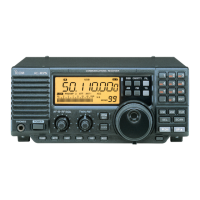10
3
INSTALLATION AND CONNECTIONS
■ Connecting to a PC
To connect a terminal unit, TNC or scan converter,
refer to the diagram below.
q Connect a terminal unit as below.
w Select RTTY mode (or USB, CW modes for HF
band data communications).
e Set the receiver to the desired frequency as at
right.
r Set the connected terminal unit to the appropriate
settings.
• Refer to the terminal unit’s instructions.
The optional 250 Hz CW narrow filters may not
pass RTT Y signa ls. B e s ure to selec t t he
appropriate IF filters corresponding to the signal
width. (pgs. 18, 19)
Frequency settings depend on the mode used.
FM mode:
[Setting frequency (displayed freq.)] = [Desired
freq.]
USB mode:
[Setting frequency (displayed freq.)] = [Desired
freq.] – [Center of Mark and Space freq.]
CW narrow mode:
[Setting frequency (displayed freq.)] = [Desired
freq.] – [Center of Mark and Space freq.] + [600 Hz]
LSB mode (for amateur RTTY):
[Setting frequency (displayed freq.)] = [Desired
freq.] + [Mark freq.]
The RS-R75 remote control software is available
to perform data setting and remote control of the
receiver.
Refer to the diagram below for connection.
D System requirements
To use this program, the following hardware and
software are required:
• IBM PC compatible computer
• An RS-232C serial port
•
Microsoft
®
Windows
®
95 or Microsoft
®
Windows
®
98
• Intel i486DX4 processor or faster (Pentium
®
100
MHz or faster recommended)
• At least 16 MB RAM
• At least 10 MB of hard disk space
• At least 640 × 480 pixel, high color (16 bit) display
■ FSK and AFSK (SSTV) connections
TU or TNC
AF IN
SQUELCH IN
to [REC]to [REC
REMOTE]
2-conductor 3.5(d) plugs
PC
PC
IC-R75
Supplied RS-232C cable (OPC-743)

